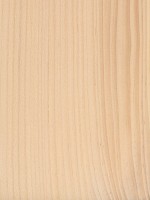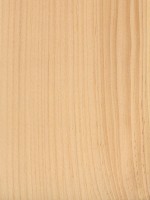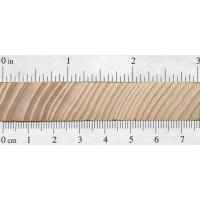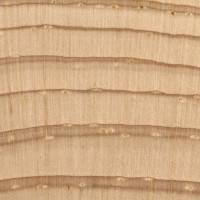 |
Common Name(s): Eastern White Pine Scientific Name: Pinus strobus Distribution: Eastern North America (also widely grown on plantations throughout its natural range) Tree Size: 65-100 ft (20-30 m) tall, 2-4 ft (.6-1.2 m) trunk diameter (historically older-growth trees were much larger) Average Dried Weight: 25 lbs/ft3 (400 kg/m3) Specific Gravity (Basic, 12% MC): .34, .40 Janka Hardness: 380 lbf (1,690 N) Modulus of Rupture: 8,600 lbf/in2 (59.3 MPa) Elastic Modulus: 1,240,000 lbf/in2 (8.55 GPa) Crushing Strength: 4,800 lbf/in2 (33.1 MPa) Shrinkage: Radial: 2.1%, Tangential: 6.1%, Volumetric: 8.2%, T/R Ratio: 2.9 |
Color/Appearance: Heartwood is a light brown, sometimes with a slightly reddish hue, sapwood is a pale yellow to nearly white. Color tends to darken with age.
Grain/Texture: Grain is straight with an even, medium texture.
Endgrain: Large resin canals, numerous and evenly distributed, mostly solitary; earlywood to latewood transition gradual, color contrast fairly low; tracheid diameter medium to large.
Rot Resistance: The heartwood is rated as moderate to low in decay resistance.
Workability: Eastern White Pine is easy to work with both hand and machine tools. Glues and finishes well.
Odor: Eastern White Pine has a faint, resinous odor while being worked.
Allergies/Toxicity: Working with pine has been reported to cause allergic skin reactions and/or asthma-like symptoms in some people. See the articles Wood Allergies and Toxicity and Wood Dust Safety for more information.
Pricing/Availability: Eastern White Pine is widely harvested for construction lumber. Prices should be moderate for a domestic softwood.
Sustainability: This wood species is not listed in the CITES Appendices, and is reported by the IUCN as being a species of least concern.
Common Uses: Crates, boxes, interior millwork, construction lumber, carving, and boatbuilding.
Comments: Eastern White Pine is one of the most common and widely used timbers for construction lumber in the northeast United States. It’s one of the three primary commercial species of White Pine, with the other two—Sugar Pine and Western White Pine—being found on the west coast.
The long, straight trunks of Eastern White Pine were once prized for use as ship masts. The king of England’s aggravating habit of marking out and reserving all the biggest and best of these trees for use in his navy lead to the Pine Tree Riot of 1772, and played a role in the events leading up to the Revolutionary War.
- Austrian Pine (Pinus nigra)
- Caribbean Pine (Pinus caribaea)
- Jack Pine (Pinus banksiana)
- Jeffrey Pine (Pinus jeffreyi)
- Khasi Pine (Pinus kesiya)
- Limber Pine (Pinus flexilis)
- Loblolly Pine (Pinus taeda)
- Lodgepole Pine (Pinus contorta)
- Longleaf Pine (Pinus palustris)
- Maritime Pine (Pinus pinaster)
- Ocote Pine (Pinus oocarpa)
- Patula Pine (Pinus patula)
- Pinyon Pine (Pinus edulis)
- Pitch Pine (Pinus rigida)
- Pond Pine (Pinus serotina)
- Ponderosa Pine (Pinus ponderosa)
- Radiata Pine (Pinus radiata)
- Red Pine (Pinus resinosa)
- Sand Pine (Pinus clausa)
- Scots Pine (Pinus sylvestris)
- Shortleaf Pine (Pinus echinata)
- Slash Pine (Pinus elliottii)
- Spruce Pine (Pinus glabra)
- Sugar Pine (Pinus lambertiana)
- Sumatran Pine (Pinus merkusii)
- Table Mountain Pine (Pinus pungens)
- Western White Pine (Pinus monticola)
- Virginia Pine (Pinus virginiana)
 |
 |
 |
 |





is the eastern whit pine fire rated. I used it on walls and ceiling of a restaurant i need to find this out asap if you are able to help
I wouldn’t use pine honestly. Turpentine was harvested from these trees . Turpentine is very flammable
Is this wood as same as northern pinewood?
Wow! I just discovered your site and I’m truly and deeply impressed. Congrats on a great job.
I was looking for SG of lumber at 12%MC and I notice that there is a low and a high SG reading.
I assume they come from different samples so should I use the average of the two for weight calculations?
Thanks
No, for weight calculations you should just use the average dried weight values. The SG values are for green wood, and 12% MC wood, respectively. This explains it a little more in depth: https://www.wood-database.com/wood-articles/specific-gravity/
250 plus year old homes were built all over the Northeast from Eastern White Pine and are still standing today. Framing, clapboards, shutters, eaves, trim, windows, doors, flooring, even the shingles on the roof and the wooden built-in gutters were Eastern White Pine. It is more rot resistant when painted than the article suggests. The largest examples of the species are found in Michigan.
Old growth Eastern White Pine from 250 years ago found in old construction, is noticeably denser than the current farmed White Pine found in lumber mills and hardware stores. Compare the two, and you’ll see its almost like two different kinds of timber. Also, old reclaimed Eastern White Pine is a lot more stable through extreme humidity fluctuations of humid summers and dry winters in heated spaces. Indeed, freshly cut then kiln dried White Pine found in most lumberyards, is much more reactive to humidity swings than old reclaimed Pine timber that’s been drying for decades, or a couple of… Read more »